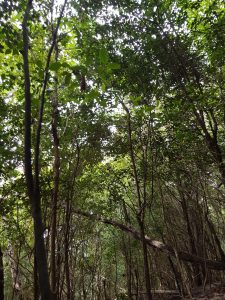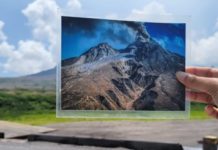In a previous post you saw the process we went through to mark out the mountain chicken release site and construct our trial ponds. This update explores the next step, increasing the temperature of the environment!
One thing we must do before we can successfully reintroduce the mountain chicken back to Montserrat, is to find a way in which we can control the deadly chytrid fungus that caused the near extinction of the species back in 2009. This is something that we have been working on extensively during this first phase of the project.
Our solution involves raising the temperature of the release site out of the range suitable for the chytrid fungus. Tests in the lab have shown us that chytrid begins to die at temperatures exceeding 28 degrees celsius; with this knowledge in mind we have begun to adapt the environment around the release site to raise the temperature beyond the threshold at which chytrid can survive. In order to do this the first series of initiatives we have been trialing have focused on utilising a great natural resource of the Caribbean… the sun!
To date we have trialed 3 methods utilising the power of solar radiation:
1. Canopy Removal
This method focuses on maximising the amount of sunlight reaching the lower levels of the forest. These areas usually act as a cool damp retreat, perfect for chytrid fungus to survive in, however by removing portions of the canopy we can increase the amount of solar radiation reaching these areas and with it the temperature. Below you can see a before and after image of the canopy removal at our trial site.


These areas should act as SAFE Havens for the mountain chicken, helping to reduce their risk of acquiring the fungus and acting to treat those already infected. These areas of increased solar radiation also enable us to implement other solar heating methods.
2. Solar heated ponds
Cool water systems usually act as a reservoir for chytrid fungus, offering the perfect environment for it to replicate in. This problem is further exacerbated by the fact that frogs infected with chytrid spend more time bathing in order to help their bodies cope with the increased pressures put on them by the fungus.
By raising the temperature of the ponds we should be able to:
a) remove chytrid fungus from the heated standing water systems
b) provide an area where amphibians infected with the fungus will spend more time bathing, increasing their body temperatures, which will in turn actively act to reduce the amount of chytrid they carry.
So far we have installed and trialled two methods to heat the ponds, both of which can be seen in the pictures below:


On the left a series of painted corrugated steel sheets semi-submerged in the pond and on the right a pump system powered by a solar panel, which acts to feed water from the pump into a solar heating mat. Optimisation of these heating methods is still ongoing, with larger trees being removed to increase exposure time to solar radiation. You can see a video of the solar pump system in action below!
4. Providing basking sites
Those of you with keen eyes will have noticed the large boulders around each of the ponds in the pictures above; they are there to act as basking sites for the mountain chickens. Just like reptiles amphibians rely heavily on their environment to help control their body temperature. This goes so far as to when they have an illness some species exhibit a behaviour known as ‘induced fever’, they’ll actively try to raise their body temperature to help their immune system fight off the infection. This behaviour has already been observed in other amphibians suffering from chytrid and we’re hoping our mountain chickens will utilise the same technique.
These rocks when left out in direct sunlight can reach temperatures exceeding 42 degrees celsius. When the frogs bask on them this high temperature should act to ‘heat-shock’ any chytrid on their underbelly. This method could prove particularly potent we have noticed in previous studies that the chytrid fungus is often most prevalent on the underside of the frog.
To keep a track of all of these changes in temperature we use specialised miniature computers known as data-loggers, which detect and record changes in temperature over time. We have placed these on the basking sites, in the pools and on the ground level of the release site and an unmodified control area. In time they will give us an excellent idea of how successful all of these changes have been in raising the temperature of the environment.
Keep your eyes peeled for the first set of data results being released early next week!







